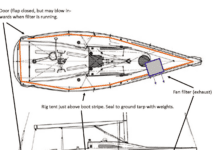Neither fish nor fowl, Skype is a VOIP, or Voice Over the Internet Protocol network, thats rapidly finding a home in the cruising community. The price is right: Free to download and free to use. After several years and as many disappointments with other Internet calling networks, Skype really works. Like so many other Skypers, we have easily fallen into the habit of calling home from anywhere in the world on the computer to talk to family or friends without any thought to the cost, because there is none. With so many cruisers on the Skype network, we keep up with old friends and new acquaintances as we go our separate ways.

In a nutshell, Skype connects two computers via the Internet for voice communications complete with live video, if you like.
HOW TO GET STARTED
Youll need a computer with Internet capability and Skype software installed. If the computer has a built-in microphone and speakers, youre all set. If not, youll need to add a headset with a microphone that you can plug into the computers audio jacks. You may want to anyway, as some built-in mics and speakers arent the best. Low volume, poor sound quality, and feedback or echoing are the most common problems.

If you want to take advantage of video calling, you will also need a webcam. Most of these gadgets have a built-in microphone, and the better ones do a nice job of eliminating echoing or feedback when speakers are used instead of a headset.
Using Skype with a Wi-Fi Internet connection to a laptop onboard works well if the Wi-Fi signal strength isn’t too low. For the free service, youll need the people you want to contact to have Skype accounts and usernames, too, as well as similar hardware setups.
THE BASICS
The Skype network has many features that make it about as close to a traditional telephone system as you can get. When a call comes in, the computer rings just like a telephone, but clicking the Answer icon is required before your conversation can begin. Skype relies on contact names instead of phone numbers, and theres no phone book. You can search the Skype network for Skype users by name or contact name, if you already know it. The software keeps the list of contact names you have acquired, and placing a call is done by clicking on the contacts name. Skype keeps track of whether your contacts are online, and it displays their status beside the contact name in your directory. A quick look will tell you whether they can be reached via Skype at any particular moment.
If the person you are trying to reach isn’t online or even if they are you can use Skypes message or chat mode to type a message. It functions as a standard interactive chat mode, so you can type messages back and forth. If the recipient isn’t online, messages are stored and delivered the next time they connect. You can talk and send typed chat messages at the same time. Its a convenient way to send an address or other informa-tion being discussed.
A feature we really like is Skypes ability to send and receive files. Its a nice way to get pictures from home or send your own pictures. There are no file-size limitations, and the transfer requires no attention after its initiated and accepted at the destination.
Skype is known and used throughout the world, so there are some obvious security issues. In your Skype profile, don’t include anything except very generic information. It can be viewed by any user, and may make you the target of solicitation or worse if you include your mailing address and home phone number.
Skype software is available for Mac, Linux, Pocket PC, and MS Win-dows operating systems. Although Skype for Windows isn’t supposed to work on Windows 95 or 98, we had good results with it when we tested it on a Windows 98 operating system. Skype provides updates to the soft-ware occasionally, and installation is seamless.
OTHER SERVICES
Skype has several options that arent free but are reasonably priced. For about $18 a year, you can purchase voicemail. It functions like an answering machine when you miss a call, but it also lets you leave a voice message for any Skype contact that you call, even if they don’t subscribe to voicemail themselves.

Skype Out is a feature that allows a call to be placed to a standard telephone number anywhere in the world. The price of the call is determined by the location you call, regardless of your own location. You must subscribe in advance and maintain a balance that the price of a call can be deducted from. The entire price of the subscription goes toward paying for calls. Placing a call to a number in the U.S. from anywhere costs about 2.1 cents a minute.
For about $37 a year, you can subscribe to Skype In and have a phone number that can be called from a standard telephone instead of a computer. You get to pick the geographical location of the phone number, so it can be a local call in the selected area and still ring your computer wherever you are, as long as youre connected to the Internet. Skype charges no fees to the person calling the number. Voicemail is included in the price of Skype In. For an additional fee, you can have up to 10 phone numbers, and they can be placed in virtually any country, city, or town. (Prices can vary.)
There are a few caveats and limitations to consider. Calls between computers spanning half the globe may not always have the same quality of sound that youre used to on a standard phone, although they often do. A high-speed Internet connection isn’t really required; we have had acceptable conversations with folks using a dialup connection, but sometimes quality suffers a bit.
Skype wont take your credit card online if you are out of the country the card was issued in, but they do accept payment via Pay Pal.
CONTACT
SKYPE, skype.com






































